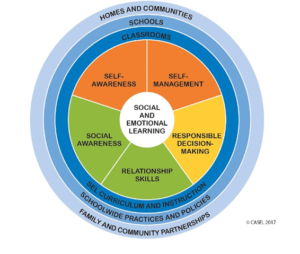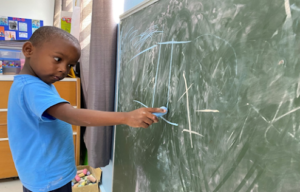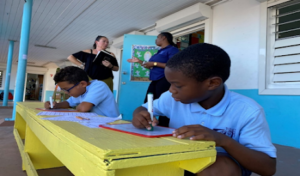How do children learn for life, how do they get to know themselves and understand others?
And how do we send them out into the world confidently?
By Ria Uiterloo
In this series, I write about competences and experiences to promote a successful life for children. In this article, three (3) educators are giving their perspective on positive approaches for children’s relationships and development.
Education and child development cannot happen without knowing a relationship with the other, with the environment and with self. Therefore, I think the need for developing Social Emotional Learning (SEL) in schools is very important. Competencies are crucial and should be a priority for student success. For me, Social Emotional Learning is LIFE.
Social and Emotional Learning involves developing competences such as self-awareness, self-management, social awareness, relationship skills and making responsible choices (see figure 1).

Figure 1 CASEL’s integrated framework promotes five core competencies [1].
I have long been associated with the Foundation Catholic Education St. Maarten and the Stichting Expertise Centrum Ervaringsgericht Onderwijs (EGO Foundation). Both organizations see the importance of Social Emotional Learning programs as an essential part of upbringing and education. I personally believe they are the basis for healthy social emotional development (to grow in language development, for example, but also in motor development). Social-Emotional Learning is the process by which pupils acquire and apply necessary knowledge, attitudes and skills so that they can better relate to themselves and others. And SEL supports social-emotional development.
Studies have shown that effective SEL programs improve cognitive development. The programs improve students’ self-regulatory ability, which in turn leads to better academic results and behavior.
As an education expert, I believe it is important that children be well supported as they grow up. At SKOS schools and Stichting EGO’s After-school programs, we have various activities, resources and tools to develop SEL competences (for example: Box full of Feelings and House full of emotions [2], programs to teach coping skills (Partnership for Children UK [3]), Habits of Covey [4] ).
Audrey Wilson, Student Care Coordinator at the Sr. Regina School on St. Maarten and Train the Trainer of coping skills programs as Zippy’s and Apple’s friends, responds in an interview about the importance of and her experience with Social Emotional Learning:
“In my view, social emotional learning cannot be separated from academic learning. Indeed, when the child’s social-emotional development has been given space, guided and supported, the aforementioned CASEL core competences can be expressed to the maximum extent.
We can challenge a child academically all day, and if we are lucky, the child manages to store, process AND make connections between different subjects/areas throughout the day. On that day, the child has not experienced what it means to lose once, to properly assess danger of a game or/and to solve a dilemma.
When we approach children mainly academically, we do not pay attention to the child’s brain that is developing intensively, mainly until the age of 8. Anyway, until the age of 23, it is still in an intensive and complex growth process.
When, especially in the first period up to age 8, we shift the emphasis to learning to (re)know your Self, developing, and reflecting on Self-Awareness, Self-Regulation, Social Awareness, Relational Skills, making Responsible Choices, we help children to eventually reach maximum academic learning, recognize their strengths and weaknesses, accept and apply them in both the academic and the socio-emotional world.
We can start this at a very young age, by making children aware of their executive functions [5]. By including their parents in this as well, parents and children learn from each other and each other’s talents. From that basic attitude, an understanding of academic talents and development will grow.
The “Zippy’s Friends” coping skills lessons, especially in grade 4, are very special to me. Around the age of 7 – 8 years children manage to reflect on behavior better, they start to make connections and understand. For example, when we work on module 3 “Starting and breaking relationships”, they know to refer back to module 1 “Feelings”, they can compare a story with a situation they have experienced. As a result, they manage to process emotions more easily, develop and refine their coping skills.”
Marcel van Herpen of Centrum Pedagogisch Contact [6], education expert, explains in a conversation from his perspective what a teacher/educator needs to consider when it comes to competences and basic needs. I first share with him how difficult teachers find it to integrate SEL competences drawn from the various sources available to them into their actions.
To my question “If you now look at the competences derived from CASEL and the (basic) needs (which a teacher/educator has to take into account) that you describe so beautifully in your books, what are good practical actions?” Marcel van Herpen responds as follows:
“Man is a psycho-social being. He thinks and acts. His mind and body are connected. And although you can distinguish all kinds of aspects of man, he is one. So, everything man experiences, influences what he thinks and what he does. The unconscious influences the conscious. Emotions affect actions. And emotions affect cognitive abilities. A child who can face the world emotionally free and uninhibited can access his potential and develop his cognitive abilities. Optimal development requires more than a stable emotional state of mind. But it is an important part of a contingent foundation.
When a child is born, he requires – besides food – emotional affection above all else. He is more or less assimilated into the environment. Security – we know it from the attachment process – is then the most important condition for further development.
A toddler discovers that he is a unique person. He wants to do everything himself. It is as if he discovers the words ‘I’ and ‘no’.
The baby asks for a relationship. The toddler for autonomy. And from then on, these two basic psychological needs revolve around each other.
The toddler starts taking more and more initiatives. The primary school pupil takes big cognitive steps. The adolescent does too, but at the same time will also try – to some extent – to break free from family ties.
So every human being needs both relationships with others and autonomy to be/become himself. The freedom a human being needs for autonomous development (needs, desires, etc.) is limited by the needs of others. Thus, in proper development, a child can articulate and practise his own needs while assessing and giving space to the needs of others. One could say that in doing so, the emancipation process and the democratisation process go hand in hand. Therefore, in a right pedagogical relationship, a child is given the space (needed to have experiences) for which he can take responsibility (needed to be considerate of others).
When educators (teachers, parents, youth leaders, trainers, etc.) align this vision, development proceeds better.”In doing so, Marcel gives practical examples:
Toddler at the chalkboard

In group 1/2, a toddler walked up to the chalkboard. He picked up a piece of chalk and started ‘scratching’. He explored the whole board. The edges, the whole middle section. Then he lays down and continued drawing. Then upside down. Then dancing. Then throwing the chalk at the board. Then using big circles. And so he continued -exploring himself and the chalkboard -for 28 minutes. The teacher was in the circle playing a game with the rest of the class. She lets the toddler have his way. She left him free. This allowed him to make discoveries he would never have made in an imposed work or a play-through circuit.
Pedagogical and didactic differentiation
In a grade 5 class, the children had to make a worksheet. The teacher allowed the children look at the sheet. She said that the children who thought they could make it themselves could start – if they would work quietly. (Freedom and responsibility). The children who had questions were allowed to wait in the circle for interactive instruction. If during the instruction children thought they could continue independently, they could continue at their own table. As a result, no one had to wait for someone else. After all, waiting is demotivating and encourages undesirable behaviour. And from the moment the teacher (relationship) was no longer needed, everyone could work independently (autonomy).
By granting autonomy from your relationship, you give children more opportunities to take responsibility themselves. That responsibility, in turn, is conditional to gaining more freedom!
Tips:
- Give children the freedom they can take responsibility for.
- Allow children experiences in which they can discover what they can do themselves, and what you as an educator are needed for.
- Watch carefully and talk regularly about what children are doing and experiencing.
- Agree with educators (teachers and parents) about the strategy you use.
- Enjoy what children can do on their own and help them reach their limits.

Marcel van Herpen thus confirms that when pupils have supportive relationships and opportunities to develop and practice social, emotional and cognitive skills in different contexts, they develop better. As teachers, parents and educators, we need to grant autonomy from the relationship and allow children to take responsibility. This is only possible if we design the environment so that children learn this at school, at home and in their environment. As we teach those skills and when confidence is given, children learn, and academic learning accelerates.
Research shows that SEL not only improves achievement, but also prosocial behavior (such as kindness, sharing and empathy), and improves students’ attitudes towards school and reduces depression and stress among students (Durlak et al., 2011).
The relationship between parents and school but also the relationship with the community can enhance the effect of the school approach by extending learning to home, neighborhood, After-school programs and Sport’s organizations/clubs (tennis, swimming, football, chess club, etc.). Social contexts, and thus social clubs, sports clubs and after-school clubs, can support classroom and school efforts, especially by providing students with additional opportunities to refine and apply different SEL skills (Catalano et al., 2004).
After-school activities also provide students with opportunities to connect with supportive adults and peers (Gullotta, 2015). They are a great venue to help young people develop and apply new skills and personal talents. Research has shown that after-school programs focused on social and emotional development can significantly improve students’ self-esteem, attachment to school, positive social behavior, school grades and achievement test scores, while decreasing problem behavior (Durlak et al., 2010).
Students are more successful in school and everyday life when they:
– Know and control themselves
– Understand the perspectives of others and interact effectively with them
– Make good choices about personal and social decisions
Alejandro Francisco, manager at Ego Foundation’s After School Programs shares a scenario.
Six- and Seven-year-old children in one of the After-school programs were engaged in a game where the group had to line up and roll a dice. The side that happened to come up when rolling determined the number of steps the player was allowed to move forward, straight forward and sideways to the left and right. The aim of the game was to see which child would eventually complete the circuit first. As the game progressed, the youth leader’s irritation increased. One pupil was very busy and distracted other pupils by making funny noises. This game in itself is a wonderful activity for promoting concentration, numeracy and other math activities, and patience. But the design compromised the strategies children could learn.
Alejandro continued: the group was large and could have been divided into 2 sections. The waiting time for children was long which reduced engagement.
He suggested that after explaining the game, the youth leader should let the children form their own groups and assign game leaders to ensure that the game is played correctly and smoothly. This promotes positive self-esteem and autonomy and increases self-respect in children.
As a coordinator, he also advises that the group leader can suggest new rules and more challenge during the game in consultation with the children. This stimulates creative ability and critical thinking skills. Children come up with their own ideas and solutions and are able to try out new things.
[1] https://selspace.ca/what-is-social-emotional-learning/
[2] https://incentiveplus.co.uk/product/box-full-of-feelings-house-full-of-emotions/
[3] https://www.partnershipforchildren.org.uk/
[4] https://aes.highlands.k12.fl.us/about-aes/the-7-habits-of-happy-kids-covey-leader-in-me
[5] https://developingchild.harvard.edu/science/key-concepts/executive-function/
[6] https://centrumpedagogischcontact.nl/ YouTube-channel for weekly pedagogical inspiration: https://www.youtube.com/c/MarcelvanHerpenpedagoog


